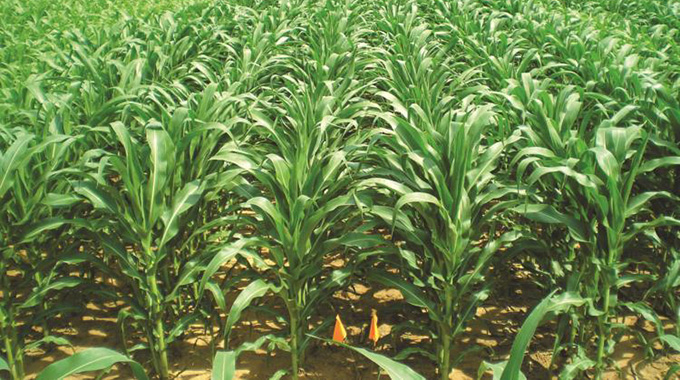Good rainy season will change narratives

The excellent rains Zimbabwe is enjoying, coupled with the determined and largely successful efforts to ensure all genuine farmers had their inputs on time, means that we are heading towards a really good harvest.
It is now near certain that we will achieve self-sufficiency and a bit extra in maize and traditional grains and slash our import bill for oil seeds, with our tobacco farmers well on their way to a record harvest of our number one export and our cotton farmers rebuilding their once vibrant sector.
The cattle farmers are looking at decent pastures, and thanks to some imaginative disease control, a large tin of tick killer each, are facing sharply-reduced disease losses.
There are reports of problems from too much rain in some areas, but usually these hide other mistakes and errors.
Water-logged fields suggest poor drainage and people chancing their arm by planting in vleis. Gullies and other signs of erosion mean not enough contour ploughing and the stripping of vegetation on slopes. Farmers with these sort of problems have a busy winter ahead of them fixing the underlying causes.
Generally, your average farmer infinitely prefers too much rain to even one percent below normal. And after two successive years of drought, and even more years of inadequate rainfall across much of the southern half of the country, most farmers find the present season even more welcoming, giving them an opportunity to restore some basic soil moisture levels, re-vegetate eroded areas, and build up organic content.
Weeding might be a backbreaking nuisance, but it also generates, in a good raining season, large quantities of organic mulch and material that can be used to rebuild and protect soils.
We need to remember that the switch to conservation farming by smallholders this season also means they have a higher than usual regard for organic content.
In fact, the good rainy season is in many ways ideal for the 2,3 million smallholder households who registered for Intwasa/Pfumvudza. They had to learn a lot of new techniques and many households that had never grown oil seeds had to learn how to plant and look after this new crop.
The programme was set up to cope with almost any sort of season, but having a bit of breathing space with decent rains must have made it easier for the families.
While bans on travel make it difficult for city people to see what farmers are doing, and what fields look like, they can get some idea in urban neighbourhoods where people plant those small plots at the side of the road and on open spaces.
And some of those plots are now at full height with the maize tasselling, while other stands look good. Even the odd late planting looks as though it might produce a crop.
A few gaps are emerging. Farmers are crying out for top-dressing fertiliser, with the Government saying the first deliveries are now being made.
It has become fairly obvious that we need to rebuild our fertiliser manufacturing capacity. We used to mine our own phosphates and lime.
We used to make ammonium nitrate by an unusual process, using surplus water at Lake Kariba that would otherwise go to waste through a floodgate to generate very cheap electricity out of peak hours and then use that to liquefy air to obtain nitrogen and use hydrolysis to obtain hydrogen.
While those elements were put through processes to make ammonia, the “waste” oxygen was sold to Zisco. We now have to use other processes, since we no longer have very cheap surplus electricity, but let us start expanding plant and capacity and looking far harder for deposits of the minerals we need.
A lot gets said and written about the need for bigger harvests to make Zimbabwe self-sufficient in food and build up modest carry over stocks in case the next season is not so good. And some discuss the need to cut back on foreign currency for food imports.
This is all important, but is not the main reason for the major effort we have made to empower our smallholders and commercial farmers.
The biggest single gain from seeing those 2,3 million households produce enough food for themselves with some left over for sale will be the raising of around half the population of Zimbabwe out of destitution and hand-outs.
If we do not have to buy food for destitute families, because they are growing their own, we have money we can use for other needs, most probably rural development, irrigation schemes and the like since it would be unfair to spend the savings on anyone else.
But for many of those families, this year will be the first time they have some cash in their wallets, virtual wallets in this modern age, and even if it is not very much for each family it totals substantial sums of money and creates huge markets for our manufacturers, or at least those who make the right products at the right price and right quality.
This is how countries with a large farmer base develop, with those farmers not just creating new real national wealth and markets, but also ensuring if you have been through land reform at some stage that this wealth is spread very widely rather than accumulating in a very few hands.
Our Vision 2030 is not just about Zimbabwe becoming a middle income country, but about Zimbabweans becoming a middle income people. The new farming systems are a crucial part of that process, and having a decent rainy season to give them a jump start is a great way to begin.
With all our economic problems generated by the lockdowns and Covid-19, our farmers are providing a strong beam of good news. Let us all hope the rains continue to the season end.







